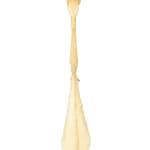Colher Edo/ Bini-portuguesa "Manilla" , Reino do Benim, Nigéria
marfim entalhado
24,5 cm
F1335
Further images
Provenance
Colecção Charles Ratton (1895- 1986), coleção Guy Ladrière, Paris, J. Jordão Felgueiras, Porto; Teresa Paramés, Lisboa.Publicações
Bassani, Ezio, African Art and Artefacts in European collections, 1400–1500, London, British Museum Press, 2000, no. 813; Trnek, Helmut, Vassallo e Silva, Nuno, Exotica. The Portuguese Discoveries and the renaissance Kunstkammer, (cat.), Lisboa, Museu Calouste Gulbenkian, 2001, p. 101, no. 9; Dias, Pedro, A Arte do Marfim—O Mundo onde os Portugueses Chegaram, Porto, V.O.C. Antiguidades, 2004, pp. 40–41; Amaral, Leonor de Liz, ‘Os marfins luso-africanos do reino do Benim (séculos XVI e XVII). Estudo histórico‑artístico e material’, Lisboa: Faculdade de Letras da Universidade de Lisboa, Tese de Doutoramento, 2022 (cat. no. 70).
A colher edo-portuguesa, talhada em marfim de presa de elefante, em alto relevo, apresenta a forma da concha larga e pouco funda, em forma de pera ou figo, terminando num elegante enrolamento que sugere uma folha tripartida. A perícia do escultor é evidenciada pela transparência da concha, cuja parte exterior é dividida a meio por uma fina nervura que acompanha a zona convexa da peça, podendo também evocar elementos marinhos como as conchas ou búzios. O cabo deste invulgar objeto é constituído por uma cabeça zoomórfica texturada, uma cabeça de crocodilo que engole um antebraço humano, terminando numa mão que segura um objeto em forma de ferradura, provavelmente de uma ‘manilha’ ou bracelete em cobre ou latão. O sincretismo desta peça é revelado pela combinação e/ou fusão de formas, motivos iconográficos africanos e europeus, com as técnicas escultóricas dos Edo, criando um estilo novo que difere tanto da arte local como da arte portuguesa (e europeia). Com efeito, o motivo esculpido na extremidade do cabo desta colher alude às manilhas levadas pelos portugueses para o reino do Benim, que serviam de unidade monetária no comércio transatlântico, tendo sido muito referidas na documentação europeia. Estas peças eram fundidas para produzir alguns objetos da arte real, como cabeças comemorativas destinadas aos altares reais (no topo destas peças se colocavam presas de elefante), assim como as placas relevadas apresentando figuras da corte e estrangeiros (portugueses), que ornamentavam o impluvium da entrada do palácio. Na arte real do Benim os materiais são muito valorizados, contendo significados específicos. A guilda da fundição de metal, a guilda Igun Eronmwon, encontrava-se no topo da hierarquia destas oficinas hereditárias, seguindo-se a de marfim (e madeira) designada por Igbesanmwan, produzindo objetos destinados aos rituais onde participava o Oba ou rei, patrono das artes. Quanto à representação do crocodilo (agbaka), animal do habitat da floresta tropical do Benim, está associado ao poder real e, simultaneamente, ao deus Olokun, deus Edo do reino subaquático, da riqueza, da saúde e da fertilidade, encontrando-se entre o mundo dos espíritos e o mundo terrestre, e que relacionavam com os portugueses, por terem chegado através dos rios e do mar. Fazendo parte do corpus dos marfins edo-portugueses ou bini-portugueses, existem atualmente 61 colheres (além de 17 saleiros e três olifantes). Todas as colheres apresentam a mesma morfologia na concha, com motivos iconográficos variados. Apenas três representam a mão na extremidade do cabo, apesar de diferirem na posição dos dedos e a nível estilístico. Uma destas peças, de maior elaboração compositiva, pertence ao museu de Viena Museum für Völkerkunde (inv. no. 91914), tratando-se provavelmente uma das seis colheres da Kunstkammern do Arquiduque Fernando do Tirol (1596, Castelo de Ambras). A iconografia relaciona-se mais diretamente com os europeus devido à posição da mão em gesto de bênção cristã. A outra, do Musée du Quai Branly em Paris (inv. no. 70.2004.31.1), é semelhante à colher do São Roque em termos de estilo e técnica de talhe. Um fragmento de colher (cabo com uma mão a apontar) encontrado em contexto arqueológico africano (Alcácer Ceguer), foi recentemente identificado como se tratando de uma colher edo-portuguesa, o que contribuiu para balizar temporalmente a produção dos marfins luso-africanos do Benim. A mão é representada em objetos como os idiofones utilizados em rituais neste reino, designadamente nos altares de antepassados dedicados à mão e simbolizava a aquisição de riqueza ou estatuto, relacionada com as capacidades dos guerreiros, caçadores e artesãos - referindo-se a existência de um idiofone em bronze que termina numa mão fechada a agarrar um peixe-lama. Segundo as tradições orais, o culto da mão remonta ao reinado de Oba Ewuare, o rei guerreiro do séc. XV, baseando-se na crença de que a mão direita ou o braço incorporam a capacidade de realização humana, bem como de proteção contra o ataque de espíritos malévolos ou de inimigos. A chegada dos portugueses coincidiu com a expansão territorial e afirmação geopolítica do Benim, encontrando-se documentada a incorporação de soldados lusos no exército Edo e as trocas comerciais e diplomáticas estabelecidas com os portugueses, que contribuíram para o enriquecimento deste reino durante o séc. XVI. Pode-se destacar que, neste período, o reino Owo - um dos povos Iorubá - encontrava-se sob a influência do Benim, pelo que as oficinas artísticas de ambos os reinos apresentavam alguma permeabilidade e, tal como tem sido referido, o motivo iconográfico das folhas - a forma da concha das seis dezenas de colheres edo-portuguesas - pode ter resultado de contributo deste povo do Noroeste da Nigéria. No Benim, a divindade Edo - deus Osun - incorpora o poder das folhas e das ervas colhidas na floresta, para serem utilizadas em preparações mágicas e medicinais. As colheres esculpidas em marfim, matéria simbólica valorizada de parte a parte, são peças reveladoras de um hibridismo cultural e artístico, lembrando que estes primeiros estrangeiros a aportar em Ughoton, antes de chegar à Cidade do Benim, foram percecionados como seres “liminares”, vindos da terra dos espíritos.
Receba as novidades!
* campos obrigatórios
Processaremos os seus dados pessoais que forneceu de acordo com nossa política de privacidade (disponível mediante solicitação). Pode cancelar a sua assinatura ou alterar as suas preferências a qualquer momento clicando no link nos nossos emails.





